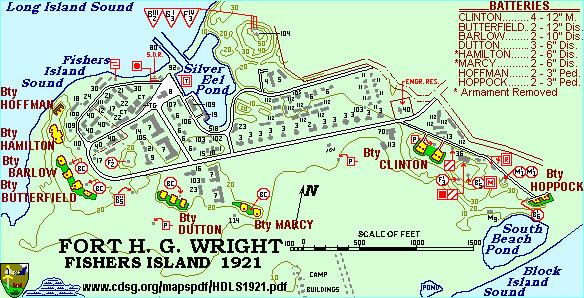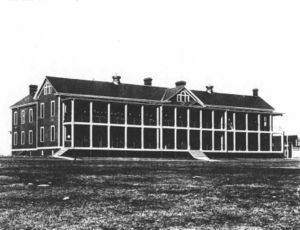Built 1898–1906 In use 1898–1958 | Open tothe public partly Garrison 11th Coast Artillery | |
 | ||
Controlled by private/Town of Southold Similar | ||
Fort H. G. Wright was a United States military installation on Fishers Island in the town of Southold, New York, just two miles off the coast of southeastern Connecticut, but technically in New York. It was part of the Harbor Defenses of Long Island Sound, along with Fort Terry, Fort Michie, and (in World War II), of Camp Hero. These forts defended the eastern entrance of Long Island Sound and thus Connecticut's ports and the north shore of Long Island. The fort was named for Union General Horatio G. Wright, a former Chief of Engineers who was born in Clinton, Connecticut.
Contents

The fort was first developed in the early 20th century and was active in the First and Second World Wars. After the Second World War, it was deactivated as a coast defense fort.

Construction and armament

Fort H. G. Wright was built as part of the large-scale Endicott Program, which recommended a comprehensive replacement of existing coast defenses. The forts were designed and built by the Army Corps of Engineers, the weapons were designed by the Army Ordnance Corps, and the forts were (by 1907) garrisoned by the Coast Artillery Corps. Fort H. G. Wright was the headquarters of the Coast Defenses of Long Island Sound (later Harbor Defenses). Construction of gun batteries at Fort H. G. Wright began in 1898. By 1906 the following batteries were completed:

Facilities for a nearby underwater minefield were also built. Battery Dynamite, on Race Point at the southwest end of the island, had a 15-inch pneumatic gun firing a dynamite-loaded projectile. It is unclear when this battery was built. This type of weapon was determined to be inferior to conventional guns and was withdrawn from service in 1904. Battery Hoppock was completed in 1905 but does not appear to have been armed until 1913, with guns transferred from Battery Greble at Fort Terry.
In an unusual move, the fort's 10-inch and 12-inch guns were replaced in 1911–1914. Battery Butterfield's 12-inch M1895 guns were replaced by the guns of the same model in 1911–12, while Battery Barlow's 10-inch M1895 guns were replaced by 10-inch M1888 guns in 1914.
World War I
Following the American entry into World War I in April 1917, changes were made at the stateside forts with a view to putting some coast artillery weapons into the fight on the Western Front. The Coast Artillery Corps manned almost all US heavy and railway artillery in that war, with stateside forts reduced to a minimum garrison to provide gun crews in France. The forts were also important as mobilization and training centers. In 1917 the four 6-inch M1903 guns of Batteries Hamilton and Marcy were removed from the fort, mounted on field carriages, and sent to France. However, a history of the Coast Artillery in World War I states that none of the regiments in France equipped with 6-inch guns completed training in time to see action before the Armistice. A forcewide restructuring of 12-inch mortar batteries, generally removing half the mortars of each battery to speed reloading, resulted in Battery Clinton losing four of its eight mortars in 1918. In many cases the removed mortars were converted to railway artillery, and this appears to have happened to Battery Clinton's mortars, but none of these were sent to France. None of the removed guns at Fort H. G. Wright were replaced, and in 1920 the carriages were ordered scrapped.
Between the wars
In 1924 the Coast Artillery Corps adopted a regimental organization, and the 11th Coast Artillery Regiment of the Regular Army was established for Long Island Sound, with headquarters at Fort H. G. Wright. In 1936–1937 the fort's 10-inch and 12-inch guns were again replaced with weapons of the same model. In 1936 Battery Barlow's 10-inch guns were replaced by weapons from Fort Wetherill in Rhode Island, and in 1937 Battery Butterfield's 12-inch guns were also replaced. Battery Barlow appears to have been deactivated in 1939, and its guns and carriages were scrapped in 1943. A 3-gun anti-aircraft battery, probably armed with the 3-inch gun M1917, was built in the 1930s. The fort included an airfield, and a balloon hangar existed 1920–1962.
World War II
From 1940–1944 the Harbor Defenses of Long Island Sound were garrisoned by the 11th Coast Artillery of the Regular Army and the 242nd Coast Artillery Regiment of the Connecticut Army National Guard. Harbor defense in the Long Island Sound area was based on building two 16-inch gun batteries at Camp Hero in Montauk. Combined with the 16-inch gun at Fort Michie, these rendered all other heavy guns in the area obsolete. Fort H. G. Wright's 10-inch and 12-inch guns, 12-inch mortars, and the remaining 6-inch guns of Battery Dutton were scrapped in 1943–1945. As most of the weapons were scrapped, the coast artillery regiments were replaced by two battalions in 1944. Fort H. G. Wright did receive some new batteries during the war, but the heavier portions of them were never mounted, as the threat from German surface ships was negligible by 1943. A 16-inch gun battery (no. 111) was completed in 1944 with the guns delivered on Mount Prospect near Wilderness Point, but the guns were never mounted. Two 6-inch gun batteries were built, one at Race Point (no. 215) in 1943 and one at Wilderness Point (no. 214) in 1944, but only the Race Point battery was armed, with M1903 guns. The Navy operated G-class blimps from the airfield during the war. A naval training school for "indicator loops" (for magnetic detection of submarines) operated on the island as well.
New World War II batteries at and near the fort included:
The Anti-Motor Torpedo Boat (AMTB) batteries listed show their authorized strength, and actual strength may have varied. All of the 90 mm mounts were designed to be dual-purpose (anti-aircraft and anti-surface). These batteries were also authorized two 40 mm Bofors guns each.
Postwar
After the war it was soon determined that gun defenses were obsolete. The fort was deactivated in 1947 and abandoned in 1948 with all guns scrapped. In 1949 the Naval Underwater Sound Laboratory established a facility on the island.
Present
All of the larger batteries still exist; Battery 214 was a private residence in the 1990s. The former military airfield is now a civilian airfield. The bolt circle for Battery Dynamite is still in place; it is probably the only bolt circle for a 15-inch dynamite gun remaining. Batteries Butterfield, Barlow, and Dutton were a municipal brush dump in the 1990s. At some point two of the mine-associated buildings were enclosed with a concrete-and-earth bunker; in the 1990s this bunker was used to store turf due to the cool, humid conditions. Most of the administrative garrison buildings still exist and have been repurposed.
